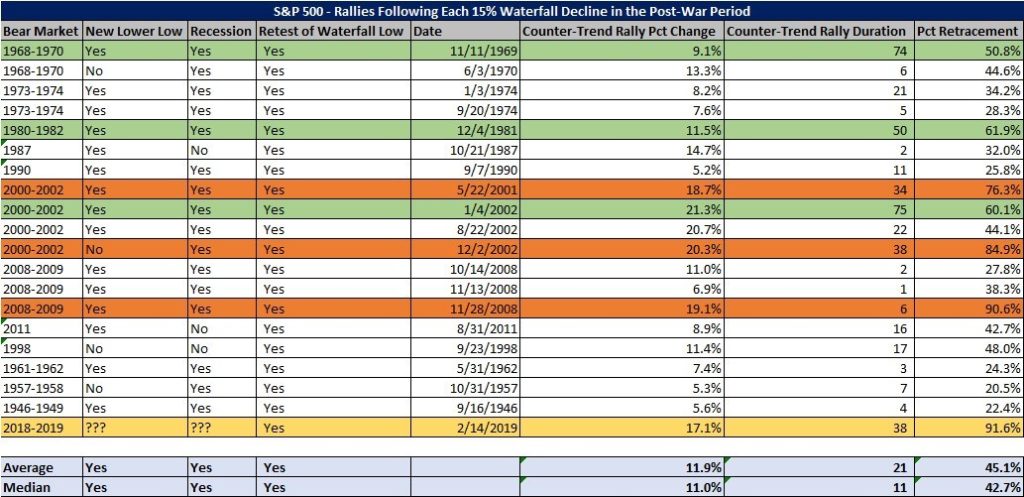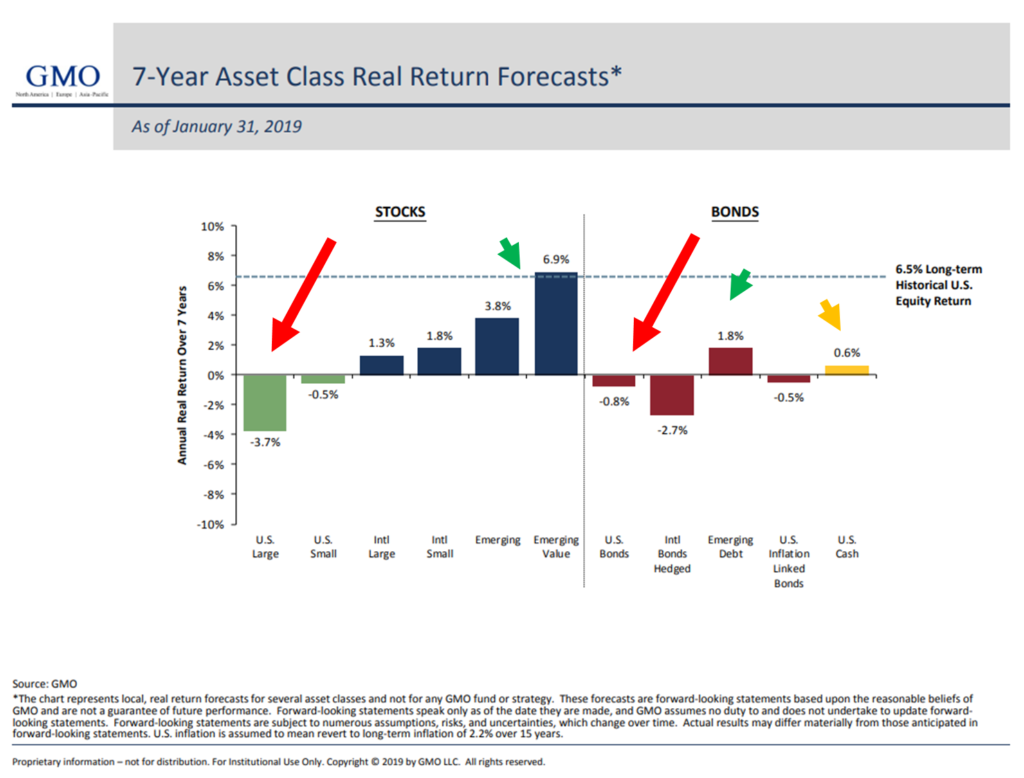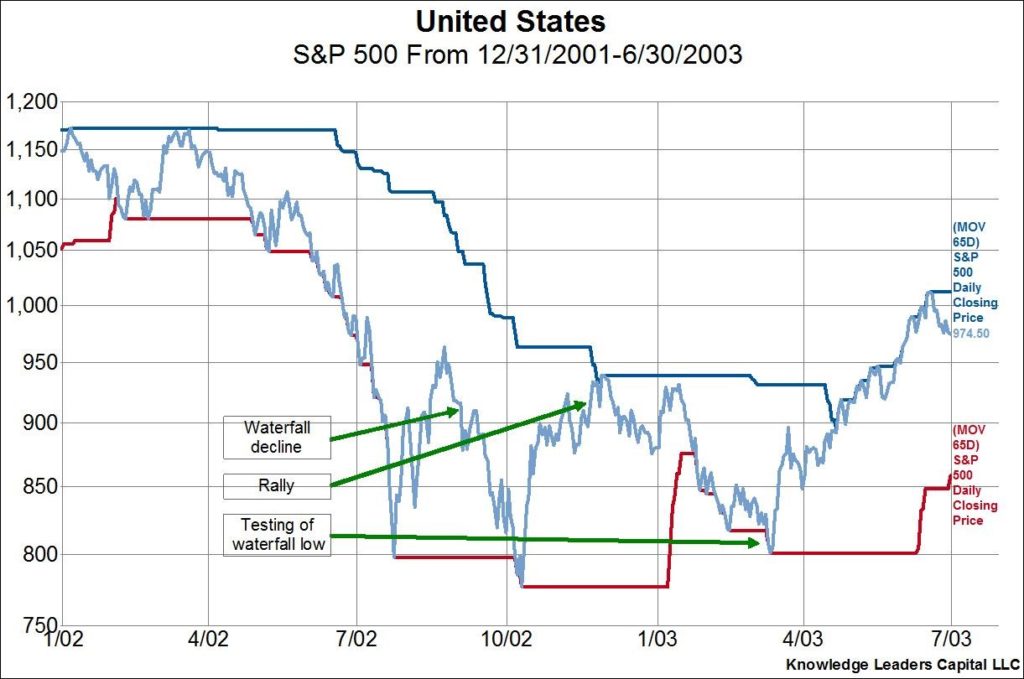“We can be blind to the obvious, and we are also blind to our blindness.” – Daniel Kahneman
Q4 hedge fund letters, conference, scoops etc
It’s been a fantastic equity market rally but keep your lights on, from a statistical perspective, odds favor a retest of the December low. I came across the following blog post from Knowledge Leaders Capital titled, “Putting this Rally Into Historical Context” by Bryce Coward, CFA. If you are looking to add to your equity market exposure, Bryce presents some good data to keep in mind.
Bryce wanted to find out what a typical rally looks like after big waterfall-like declines take place. Such as what occurred in December. This is what he learned:
- The rallies after those waterfall declines have lasted anywhere from 1 to 74 days and have retraced 20-90+% of the initial decline. Noting, that’s quite a wide range in both duration and magnitude of the move.
- His important find was universal similarity that in 19 of 19 post-war instances of a 15% uninterrupted decline (excluding the current one), the stock market ended up retesting the waterfall low in some fashion.
- That said, the big rally we’re living through is not completely unprecedented after a waterfall decline. Indeed, there were three cases of rallies lasting longer (those highlighted in green in the table below) and three instances of the rally retracing at least 75% of the waterfall decline (those highlighted in orange).
This past week, the S&P 500 Index rose back above its 200-day moving average trend line. Does that line hold? We hope so. Will the December 24, 2018 pre-Christmas low be retested? 19 for 19 is a pretty good batting average. If it doesn’t get tested, it would be an outlier. And Bryce correctly noted, “outliers are common in this business.” I found Bryce’s piece useful in terms of putting the recent rally into historical context.
When you click through to the Trade Signals section (link below), you’ll see daily investor sentiment is back up in the “Extreme Optimism” zone (a bearish signal for equities). I suspect it’s time to wait for a retest of the recent low before getting too excited. With the “Fed Put” back in play that may be a better place to add risk exposure.
But do keep in mind that the market remains richly priced; therefore, probable 7-year and 10-year coming returns are low (even negative). This next chart from GMO hit my inbox yesterday. Each month GMO runs their fundamental-driven formulas to calculate coming 7-year real returns for various asset classes. If you’re a long-time reader, you’ve seen this chart before. I share it because GMO has an excellent track record of forecast-to-outcome. Not guaranteed, not perfect but not to be ignored. Red arrows point to low negative coming real annualized returns. Red is bad, green is good (well, at least better) and yellow’s a dud.
Source: GMO
Just what does -3.70% per year mean? There are thousands of ways we can get to -3.70% per year over seven years. Below I provide three illustrations. The only thing I can guarantee you is that it won’t be any of the three sample paths below. So keep that in mind. The idea here is to give you a sense for how compounding works and, frankly, how ready we must be to seize on opportunity.
Source: CMG Capital Management Group
Far too many investors focus on yesterday’s returns and project them forward. Keep your eye on GMO’s and other well-studied valuation/forward return processes. It helps to keep me balanced in terms of risk/reward and portfolio sizing. When the hamburgers are expensive, you don’t get as much meat for your money. If you are an equity investor, sit tight, manage downside risks and get aggressive when you get more meat for your money. I think in presents in the next recession (2020 or 2021). That may look something like February 2021 in Path 2.
Bryce goes on to show two cases (of the 19 for 19) that went on to retest their lows. I share them when you click through. Also, Brexit is coming into focus and risks are mounting: China trade talks, EU auto tariffs, and Trump. You’ll find highlights and a link to an excellent article from Ambrose Evans-Pritchard. It’s witty with bite. Keep your seat belts fastened.
Finally, you’ll find a fun personal story and a few pictures from my Florida visit attending the Inside ETFs Annual Conference. Grab a coffee and find your favorite chair. A quick read this week. I’m limping home with a smile on my face, a bit out of gas and in search of a very cold IPA. Hope you’re doing great! Best to you and your family!
♦ If you are not signed up to receive my weekly On My Radar e-newsletter, you can subscribe here. ♦
Follow me on Twitter @SBlumenthalCMG
Included in this week’s On My Radar:
- 19 for 19: A Probable Retest of the December Low
- Brexit and Trump vs. EU Trade Wars – Buckle Up!
- Trade Signals – Testing the 200-day Line – Breaking Higher?
- Personal Note – When You’re Dying, Call the Doctor
19 for 19: A Probable Retest of the December Low
So readers can get a visual depiction of what a waterfall decline followed by a large counter-trend looks like, I’ve pasted below two examples of such action. The first took place throughout 2001. In that case, the stock market sold off in waterfall fashion from February through early April. Then, a counter-trend rally took the market up 19% through most of May. Stocks then topped out at resistance and proceeded to make a new low into the fall of 2001.
The second instance depicts the bottoming of stocks in the 2002-2003 period. The market declined by about 20% from August through October 2002. Then the market rallied by 21% over six weeks into late November before turning down again into the spring of 2003 to ultimately test and hold that 2002 low. In this instance, we can clearly see how the bottoming sequence in 2002-2003 was a process in which the 800 level on the S&P 500 was touched on three occasions with intermediate rallies in between.
Bryce concludes, “Will the current market go back and revisit those Christmas Eve lows? It would be an outlier, but outliers are common in this business. Either way, it’s useful to put the action we’ve seen recently into historical context, a context that shows rallies lasting longer than the current one and retracing large amounts of the previous waterfall decline.”
Thanks Bryce… excellent post.
Brexit and Trump vs. EU Trade Wars – Buckle Up!
Put the following two items on your radar. Both are recent articles from The Telegraph’s witty and sharp Ambrose Evans-Pritchard. You can find them and more at The Telegraph. It’s a subscription service and it’s worth the price of admission.
- Brexit – A no-deal Brexit starts to lose its terror as the EU draws up survival plans
I believe the topic is confusing noise for most Americans and it’s been hitting the wires for a long time. In simple terms, Britain is negotiating a divorce agreement with the EU. Like most divorces, it’s complicated, emotional and a little ugly. For the economies, it comes down to cross-border trade deals. Keep March 30, 2019, on your radar. That’s the line in the sand Brexit date. Britain’s Theresa May looks unable to make the deal she cut with the European Union through Parliament. My go-to source is Evans-Pritchard and here is how he concluded yesterday’s article:
As we enter the final weeks, it is becoming clearer that the long-predicted doomsday scenario of March 30 will not happen even in a no deal rupture. At that moment Brussels will instantly lose the leverage of the Article 50 process. It will instead find itself having to explain to EU national capitals how it so misjudged the Brexit negotiations.
We will be in a new situation. Britain will be in a mess: Europe will be in a mess. Both will have a strong incentive to sort it out in a practical fashion. Ideology will no longer cut much ice.
Perhaps it is a wicked thought, but I cannot bring myself to share Sir Oliver Letwin’s alarm over the “terrifying” prospect of a no-deal. For me the terror peaked months ago. It has since been ebbing away. It is almost tempting to let events run their course.
The immediate risks are to economic activity and with Europe likely in recession, what is happening is not stimulative to the economy. It is disruptive to trade in the short-term.
- Trump loads the gun for car tariffs against Europe, invoking ‘national security’ – by Ambrose Evans-Pritchard, The Telegraph
The Trump administration is poised to rule that car imports into the United States pose a legitimate threat to national security, clearing the way for draconian tariffs of up to 25pc on shipments from Europe and the rest of the world.
A contentious and long-running probe by the US commerce department is to issue its verdict on Sunday. Trade experts say the broad thrust is already known and the dossier is sitting on the Oval Office desk of President Donald Trump. “We think they will find some kind of national security threat. This was probably predetermined in advance, although nobody will admit that,” said William Reinsch, the veteran ex-chief of the National Foreign Trade Council.
The White House will have 90 days to respond, picking from a menu ranging from targeted measures on hi-tech components and electric vehicles all the way up to 25pc tariffs on all imported cars, as favoured by in the past by Mr Trump.
Such drastic action would effectively shut down 10pc of trans-Atlantic trade and lead to retaliation across the world, causing havoc for complex supply chains. It would revive fears of a tit-for-tat trade war between the world’s two biggest blocs and bring the rally on equity markets to a shuddering halt.
I’m not arguing right or wrong. I’m suggesting this will lead to volatility and, if a hard-Brexit hits and/or trade wars escalate with the EU, the global equity markets won’t like it and risk recession will accelerate. Europe is already likely in recession. We have no idea how negotiations will play out. As Kahneman says in the intro quote above, “we are also blind to our own blindness.” We simply don’t know what we don’t know. There are likely to be unintended, unanticipated consequences. Oh, and of course, China trade negotiations are ongoing. Stay tuned!
Trade Signals – Testing the 200-day Line – Breaking Higher?
February 13, 2019
S&P 500 Index — 2,730
Notable this week:
You’ll see in the “Dashboard” section there are a number of trend signals nearing buy signals. Shorter-term signals, like Volume Demand vs. Volume Supply have turned bullish. I favor intermediate trend signals to minimize trading and whipsaws. One of the most popular trend rules is called the “golden cross.” It occurs when the 50-day moving average (an intermediate-term trend measurement) crosses above or below the 200-day MA trend line (a long-term trend measurement). Signals indicate the market is rising in the short term relative to the long term (a bullish signal) or falling (a bearish signal). You’ll find the 50-day vs. 200-day MA chart on the S&P 500 Index below. As well as the NDR CMG U.S. Large Cap Long/Flat model, my personal favorite.
Click here for this week’s Trade Signals.
Important note: Not a recommendation for you to buy or sell any security. For information purposes only. Please talk with your advisor about needs, goals, time horizon and risk tolerances.
Personal Note – When You’re Dying, Call the Doctor
“Our most dangerous critic is the one inside our own head. Don’t listen to the critic.
Listen to your heart that knows you were born for greatness.” – Jon Gordon (@JonGordon11)
Two up with three holes to go. Playing well, we were confident the match was in hand. Money was on the line. The golf match goes for 18 holes. Each hole is worth a point. Win a hole and you’re up one. Your opponent wins the next hole and you are back to even. Erik and me vs. Andy and Dr. P. We were two up after nine holes. We remained two up with three holes to go. Then, Doc caught fire.
Doc bogies 16 for a net par and a win. One up with two to play. Doc pars the 17th hole for a net birdie and a win. In a blink, the match is suddenly even with one hole to play. Doc stepped to the tee on 18 and striped it down the middle. Andy’s ball went left. Erik and I were in good shape. Doc’s second shot on the par five, a three wood down… right down the middle. Two hundred yards left to the pin.
Have you ever seen a great athlete “in the zone?” It’s that moment when everything slows down. You don’t think, life slows down, you are singularly zeroed in on that moment. My partner whispered to me, “Look at Doc, he’s in the zone.” And boy, was he. The green was narrow. Long from the front to the back. Water on the right. Doc stepped up and hit a baby draw to within five feet of the hole. Andy, with no shot at helping his partner on the hole, yells out, “When you’re dying, call the Doctor.” We all laughed. Doc didn’t flinch.
My approach shot was just ok. On the green in three but 15 feet from the hole. Erik put his third shot to within seven feet. I missed but Erik sunk his putt for a birdie. The pressure turned to Doc. Make it and the match is tied, miss it and Erik and I win. Thirty dollars on the line… but it wasn’t about the money. Doc is a retired cardiologist, a former athlete, a humble and wonderful man. And as you might expect, cool under pressure. After Doc sunk the putt, Andy fell to the ground, looked to the sky and yelled, “Doc, my heart, you saved me.” That was a really fun day.
It was great to see so many friends at the Inside ETFs Annual Conference. I have to admit it took me a few days to recover. Up early, late dinners and red wine. I know, poor Steve. I learned a lot and had a great time.
We celebrated Brianna’s birthday last Saturday evening at the W Hotel in South Miami Beach. Yes, the old guy hit the clubs… I now understand the talent certain DJs have. Home at 3 am. Not built for that… and what a crazy world that exists on South Beach. It was fun to see.
This year I found myself spending more time networking in the sponsor area and less time attending sessions. I did a number of interviews. This one was with NASDAQ’s Jill Malandrino on the market and my four favorite recession indicators:
Click here to watch video.
Tom Lydon from ETF Trends… I remember in the 90s when he transitioned 100% to ETFs. He had a vision, took a chance and has lead the way. He’s the leading voice on all things ETFs. Proud of you, friend. You can follow Tom on Twitter @TomLydon
I’ll be in NYC for meetings next Wednesday. Utah follows on February 27 to March 1 for a Winter Symposium on best practices and trade execution (and skiing!). I’ll be in Austin on April 3 and Dallas on April 4 with John Mauldin for evening speaking engagements and back to Utah for a week of vacation April 5-12. I’ll be back to Dallas on May 13-16 for the Mauldin Economics 2019 Strategic Investment Conference.
If you are an individual investor in the Austin or Dallas area, please email Linda Cianci (linda@cmgwealth.com) if you’d like to attend the April 3 or 4 events. If you are an advisor and would like to get together for a coffee, John and I would love to meet with you and talk about the markets, the economy and you. Please email Linda if you have time to meet with us.
Thank you for reading On My Radar. Please know how much I appreciate you and the time you spend with me each week. Do have a great weekend.
Best regards,
Stephen B. Blumenthal
Executive Chairman & CIO





